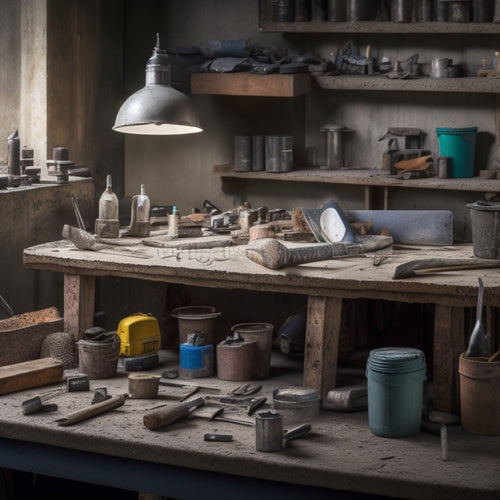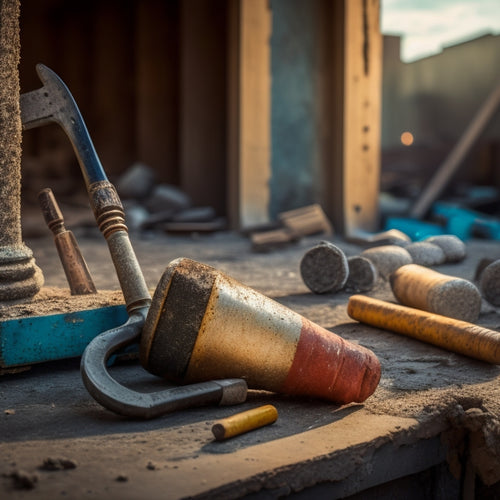
3 Best Tools for Efficient Concrete Preparation
Share
You'll need three essential tool categories in your concrete preparation arsenal to guarantee a strong, smooth, and durable finish: a reliable mixing bucket with a smooth interior, corrosion-resistant material, and measurement markings; powerful drilling and grinding machines, like a high-quality drill with adjustable speed control and drill attachments; and specialized finishing accessories, including smoothing trowels, edging tools, and jointing tools. By having these tools at your disposal, you'll be well-equipped to tackle any concrete preparation task efficiently. Now, take a closer look at each of these tool categories to reveal the secrets to a flawless concrete finish.
Key Takeaways
• A heavy-duty mixing bucket with a smooth interior and curved design ensures efficient concrete mixing and prevents material waste.
• A high-quality drill with adjustable speed control and a mixing paddle attachment is essential for fast and thorough concrete mixing.
• A concrete grinder is necessary for preparing surfaces and achieving a smooth finish, especially for large concrete projects.
• Edging tools and jointing tools help create clean edges and controlled joints, preventing cracks and ensuring a professional finish.
• Smoothing trowels and finishing blades are crucial for eliminating imperfections and fine-tuning surfaces to achieve a high-quality concrete finish.
Mixing Bucket Essentials
When preparing concrete, you'll need a reliable mixing bucket equipped with the right accessories to guarantee a uniform mix and minimize waste. A sturdy, heavy-duty bucket made from durable materials such as steel or high-density polyethylene (HDPE) is essential.
The bucket's material should be resistant to corrosion and able to withstand the abrasive nature of concrete. Look for a bucket with a smooth, non-porous interior to prevent the concrete from sticking and making it easier to clean.
In terms of mixing techniques, a bucket with a curved or angled design allows for more efficient mixing and helps to reduce the risk of air pockets. Additionally, consider a bucket with measurement markings to ensure accurate mixing ratios.
You'll also want to invest in a mixing stick or trowel specifically designed for concrete mixing. These tools will help you achieve a consistent mix and prevent over-mixing, which can lead to a weakened concrete structure.
Power Tools for Speed
With your mixing bucket and accessories in place, you can now turn your attention to power tools that'll greatly boost your concrete preparation speed and efficiency.
When it comes to power tools, you'll want to invest in a high-quality drill that can handle heavy-duty tasks. Look for drills with robust motors and adjustable speed controls to guarantee peak performance. Don't forget to pair your drill with the right drill attachments, such as mixing paddles or whisk attachments, designed specifically for mixing and blending concrete.
Another essential power tool is a concrete grinder, which is perfect for smoothing out rough surfaces, removing old coatings, and preparing the concrete for finishing. When operating a concrete grinder, always wear protective gear, including safety glasses, gloves, and a dust mask to avoid exposure to harmful debris.
Consider a grinder with a variable speed control and adjustable handle to guarantee comfort and control during extended use. By incorporating these power tools into your concrete preparation workflow, you'll be able to work faster, safer, and more efficiently, resulting in a higher-quality finish.
Finishing Touch Accessories
You'll need a range of finishing touch accessories to achieve a professional-looking finish, including tamping tools, edgers, and jointing tools that help refine and perfect the concrete's surface. These accessories are essential for ensuring a smooth, even finish that's safe and durable.
| Accessory | Description |
|---|---|
| Smoothing Trowels | Used to smooth out the concrete surface, removing any imperfections or bubbles. |
| Edging Tools | Designed for creating clean, sharp edges around the concrete slab. |
| Jointing Tools | Help to create controlled joints in the concrete, preventing cracking and damage. |
| Tamping Tools | Used to compact and flatten the concrete, ensuring a solid foundation. |
| Finishing Blades | Designed for fine-tuning the concrete's surface, removing any minor imperfections. |
When choosing finishing touch accessories, prioritize safety and durability. Look for high-quality tools that are built to last, and always follow the manufacturer's instructions for use. By investing in the right accessories, you'll be able to achieve a professional-looking finish that's both safe and impressive.
Frequently Asked Questions
How Do I Prevent Concrete From Drying Out During Preparation?
When preparing concrete, you'll want to prevent it from drying out to guarantee ideal strength and durability.
To do this, focus on moisture retention by applying a curing compound or misting the surface with water regularly.
Implementing proper curing techniques, such as using plastic sheeting or wet burlap, will also help retain moisture.
What Safety Gear Is Necessary for Concrete Preparation?
As you plunge into concrete preparation, remember that safety is the anchor that holds your project together.
You're not just mixing cement; you're handling a recipe for potential hazards.
Don't take a chance - gear up! You'll need safety goggles to shield your eyes from flying debris and protective gloves to prevent skin irritation and cuts.
Invest in a dust mask, steel-toed boots, and a long-sleeved shirt to complete your protective armor.
Can I Use a Drill for Mixing Small Batches of Concrete?
When mixing small batches of concrete, you can use a drill, but it's essential to choose the right type.
A hammer drill or impact driver is ideal, as they provide the necessary torque and speed for thorough mixing.
Employ a slow, controlled mixing technique to avoid splashing and uneven distribution.
Always maintain a firm grip on the drill and keep your work area clean to prevent accidents.
How Often Should I Clean and Maintain My Concrete Tools?
You're wise to prioritize tool maintenance to guarantee your concrete projects turn out smoothly.
To maximize tool lifespan, you should establish a regular maintenance schedule. Clean your tools daily, and perform thorough inspections weekly. Remove any concrete residue, dirt, or debris that can compromise tool performance or safety.
Set aside time monthly for more extensive maintenance, such as lubricating moving parts and sharpening blades. By staying on top of maintenance, you'll prevent tool failure and reduce the risk of accidents.
Are There Any Eco-Friendly Concrete Preparation Alternatives?
As you venture into the domain of eco-friendly concrete preparation, you'll discover a world of sustainable materials and green additives that'll make you feel like a master builder of the modern era.
You can opt for cement alternatives made from industrial by-products, recycled materials, or even agricultural waste.
These innovative solutions reduce environmental impact without compromising performance or safety.
Conclusion
You've got the foundation laid, and now it's time to pour the concrete.
With the right tools, you'll be building a strong and sturdy structure in no time.
Think of your concrete preparation process as a well-oiled machine - each tool is an essential gear that keeps the machine running smoothly.
By incorporating these essentials into your workflow, you'll be constructing a masterpiece that will stand the test of time.
Related Posts
-

7 Must-Have Tools for Concrete Repair Organization
To effectively organize your concrete repair projects, you'll need a thorough toolkit that includes a well-planned st...
-

Top Tools for Concrete Repair Success
When it comes to concrete repair success, you'll need a well-stocked toolkit with essential hand tools like trowels, ...
-

5 Tips for Splitting Concrete With Second-Hand Tools
When splitting concrete with second-hand tools, you'll need to be strategic to avoid wasting time, money, and putting...


